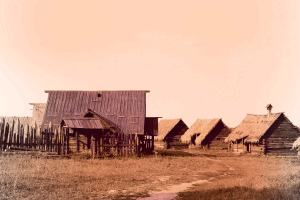The Maiden of Ludmir
| November 6, 2013
On 22 Tammuz/June 11 2004 a hakamas matzeivah took place on Har HaZeisim at the newly discovered gravesite of Chana Rochel Webermacher (1806–1888). It was the 116th yahrtzeit of the “Ludmirer Moid” or Maiden of Ludmir as she was also known.
The story of the only chassidish female who behaved like a rebbe — fiering tisch accepting kvittlach and performing miracles — but didn’t belong to any of the chassidic dynasties has generated many articles books and plays in countries around the world. From these many accounts it is possible to piece together a picture of one of the most fascinating lives of the last century.
A Rebbe’s Blessing
Chana Rochel’s story begins in the shtetl of Volodymir Volhynia (then Russia today northwestern Ukraine). Called Ludmir by its Jewish inhabitants the shtetl is associated with the Tosfos Yom Tov Rav Yom Tov Lipman Heller who served as rav there from 1634–1643 and the Noda B’Yehudah Rav Yechezkel Landau who attended yeshivah there in the 18th century. Another prominent citizen of Ludmir was the founder of the Karliner dynasty Rav Shlomo HaLevi who settled in the town in 1786.
Munish Webermacher and his wife a wealthy couple living in Ludmir had been childless for over ten years when they were given a blessing for children by a chassidishe rebbe. Although all sources agree that Munish was a chassid of the Maggid of Chernoble Rav Mordechai Twersky they differ as to which rebbe gave the brachah that produced the Webermachers’ brilliant red-haired daughter. Since there is no documentary evidence regarding this fact — most written accounts were published decades after her birth — some historians of Chassidus such as Shmuel Abba Horodetzky a grandson of Rav Aaron of Chernoble and writers such as Yochanan Twersky another scion of the Chernobler dynasty and author of a Hebrew novel about the Maiden of Ludmir attribute the blessing to the Maggid of Chernoble.
On the other hand writers Menashe Unger a brother-in-law of the late Bluzhever Rebbe and Ephraim Taubenhaus a descendant of the Maggid of Mezeritch who wrote much about the Maiden of Ludmir claimed it was the Seer of Lublin who told the Webermachers that he foresaw a child being born to them within the year who was going to have a very lofty soul.
Chana Rochel was unlike other children who liked to play. She was always hungry for knowledge and begged to learn Torah. Her father hired private tutors for her but tried to dissuade her from learning Gemara. When she continued to beg him to teach it to her he finally humored her and permitted her to learn hoping she would find it too difficult and lose interest. Instead she became an outstanding student and became renowned as a “talmid chacham.”
The awe-inspiring kavanah she exhibited when she davened three times a day set her apart as an unusually holy girl. When she reached bas mitzvah age she insisted on putting on two sets of tefillin those of Rashi and Rabbeinu Tam in private. Her father who was very upset with her behavior took her to his rebbe hoping the Maggid of Chernoble would dissuade her from behaving like a male.
Oops! We could not locate your form.

